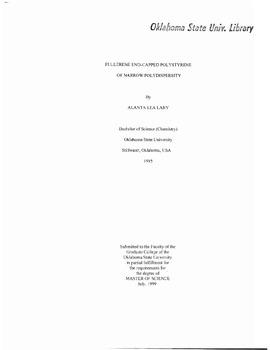| dc.description.abstract | Using a free-radical polymerization method, we were able to produce polystyrene that chemically incorporated C60� However, the polymers formed in the presence of C60 had highly branched structures and showed a dramatic decrease in the length of their polymer chains. An alternative method for producing polystyrene was employed - living polymerization. These polymerizations avoid a termination step so that chain ends remain active even after all the monomer has been polymerized. Living polystyrene was prepared by a stable free-radical living polymerization mechanism. The presence of a radical on the end of the polymer chain end allowed for reaction with C60. These end-capping reactions gave products that were analyzed with size exclusion chromatography (a separation method which distinguishes molecules by their size) equipped with UV, refractive index, and viscosity detectors. The number of polystyrene chains added to the C60 in these product mixtures was mainly 0, 1 or 2. Using molar ratios of 1, 2 and 4 polymer chains per mole of C60 during the reaction produced nearly identical results. Increased polymer content in the reaction mixture does not effect the resulting products. The products were affected when residual monomer was present during the end-capping reactions and when the reaction solutions were cleansed of by-products produced by end-capping reactions. More of the resulting product had two polymer chains attached to C60 in these latter scenarios. Our goal was to create a plastic film that contained C60 for use in protective optical devices. With the C60 bonded to the end of a polymer chain, the new material could be processed like any plastic. The optical properties of C60, combined with the utility of polystyrene results in a material with the best qualities of both of these substances. | |
